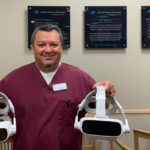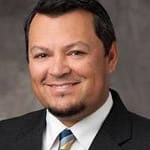
Dr. Lagunas with two new AdaptDx Pro devices he purchased from MacuLogix. The technology has transformed care in his practice while spurring profitability.
Sponsored Content
By Claudio Lagunas, OD
Sept. 29, 2021
We’ve been testing dark adaptation speed for years, beginning with the tabletop unit and then later with the head-mounted AdaptDx Pro. This simple test provides us with vital information about retinal functioning to help us detect and monitor AMD—and I thought we were doing great. Patients were happy and we were catching a lot of AMD that we didn’t know we had in our practice. But that was just the beginning.
From 17 to 100+ Tests Per Month
Before we jumped on board with the AMD Excellence Program, our utilization of the AdaptDx Pro was inconsistent. We would only run 15-20 Rapid Tests per month, and the number of weekly tests would change because we were ordering tests inconsistently, causing disruptions in our patient flow. We wanted to do right by our patients, but we couldn’t figure out the best approach on our own.
Fortunately, our MacuLogix Practice Management Consultant (PMC) showed us how, teaching us several small tips that went a long way toward helping us achieve our goals. For example, she introduced the simple concept of smart scheduling to make sure we aren’t scheduling our 50+ year old patients back-to-back or clustering them in the morning or afternoon. She suggested our technicians “huddle up” every morning to review the day and create a game plan. By knowing exactly which patients would be tested, when, and by whom, throughout the day, dark adaptation testing has quickly become planned and predictable, rather than the exception.
In that first month, we tested 90 patients—six times more than the previous month—and are now averaging just over 100 tests per month. We’ve implemented and continue to maintain this incredible improvement without adding staff (other than Theia, the onboard artificial intelligence technician) and with only minor changes to our workflow.
AMD Excellence Program Details
1. Device Training: As the core training session for all AdaptDx Pro® customers, this virtual, hands-on education focuses on getting your team comfortable using the device. You will gain confidence with the technology and learn how to work with TheiaTM (the on-board AI technician) to guide patients through the test. At the end of the session, your MacuLogix Practice Management Consultant (PMC) will observe a team member setting up the device for testing and provide coaching tips.
2. Practice Implementation and Program Launch: This step of the process will align your entire team thorough implementation, which includes a working session with key team members, and then through your program launch with your entire team.
3. Weekly Check-In: Your MacuLogix PMC will schedule weekly calls with your practice’s AMD leader to catch up on progress, understand roadblocks, modify processes and answer questions. The PMC will also check in to see how your team is performing against your goals.
4. Ongoing Support: To help you maximize your success and maintain your efforts to capture and monitor AMD, you’ll have access to PMC support and AMD enrichment sessions on the AMD Academy.® In addition, you can also attend User Groups. These peer-to-peer learning forums provide an opportunity to talk to other optometrists, ask questions and learn how others are achieving success.
More AMD Than We Thought
In the first six weeks, we tested 152 patients and 42 percent of them exhibited impaired dark adaptation necessitating a return medical visit for further evaluation. This follow-up visit included an OCT to evaluate the macular structure and an AdaptDx Pro Extended Test to determine the extent of the dark adaptation impairment. With the Rapid Test protocol part of the workup for our patients 50 and older, and accommodating the patients needing the Extended Test at a follow-up visit, we needed more resources.
Sometimes, our tabletop and our headset were both tied up and we were delaying tests on some patients whom we had planned to test. This presented an ethical challenge. Now that we knew that we wanted to find all the AMD there was in our practice, we felt strongly that we had to give this our full attention, with no excuses for delaying any testing.
We had a common situation in a multi-doctor practice, where a couple came in at the same time and they each saw a different optometrist. The wife underwent the Rapid Test and needed to be brought back for her Extended Test and OCT. During the second visit she asked why her husband’s dark adaptation speed hadn’t been tested as well; and, of course, we had no good answer other than that we didn’t have enough units available to test them both that day.
Other Articles to Explore
None of us like to have this conversation because we pride ourselves on giving every patient a consistent level of care. This realization cemented the decision for us to acquire an additional headset, which turned out to be an easy decision since we already had a clear understanding of the ROI.
Today, dark adaptation testing is the norm in our practice, rather than the exception. Every single patient age 50 or older gets tested and monitored accordingly. If you had told me a year ago that my AMD volume would jump so dramatically, I would not have believed you. But now I know which of my patients need to be monitored more closely so we can safeguard their vision for years to come.
 Claudio Lagunas, OD, is the owner of Lifetime Eyecare Associates in The Woodlands, Texas.
Claudio Lagunas, OD, is the owner of Lifetime Eyecare Associates in The Woodlands, Texas.

























